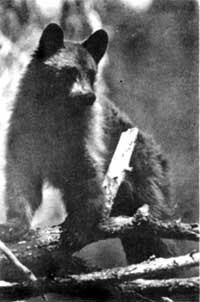|
Volume XXI - 1955
Breakfast Interrupted
By Orville Page, Ranger Naturalist
On the morning of July 31, 1954, I was making my way toward the rim
of the lake. As I approached a meadow area, I chanced upon a Columbian
blacktailed doe and her two fawns. The interesting part of the
observation was that the two fawns were busily nursing the doe. As
quietly as possible the camera was made ready, but the ever-alert mother
sensed the presence of an intruder. Before a picture could be taken,
mother and offspring were bounding gently and gracefully off through the
meadow, leaving a disappointed photographer but a greatly enriched
observer of nature.
Bear Statistics
By Richard M. Brown, Assistant Park Naturalist

A young bear surveys his surroundings from a mountain
hemlock lookout
From Kodachrome by Welles and Welles
|
William Rosenbalm -- Bill to many of us -- Truckdriver during the
1955 season, has served as a member of the maintenance staff in the park
for several summers. He is therefore particularly well acquainted with
the area, and he has come to know and recognize individually many of the
bears that live here. On September 12, 1955, I finally found the
long-awaited opportunity to chat with him for a while about "our" bears
and to visit with him one of the places in the park bears frequently
gather.
My patience was well rewarded by a most interesting conversation and
a view of more bears at liberty that I had ever before seen all at one
time. During this period, fourteen different bears, including eight
adults and six cubs, were in evidence at one time or another. This
occasion also gave me a chance to summarize Bill's knowledge as of that
date concerning the bear population in the park, with particular
reference to the latest additions. The most recent previous study of the
bears in this respect is that of Roland D. Walters (1953.
Observations and census of the black bear in Crater Lake National
Park. Nature Notes from Crater Lake 19:26-28), who reported a total
of forty-one; this included twenty-two adults, six second-year cubs, and
thirteen first-year cubs.
As a result of my discussion with Bill, thirty-two bears of the
park's total were accounted for as of that time. Of these, thirteen are
adults and nineteen are cubs: the latter are all assumed to be
first-year cubs. In spite of some possible error in this assumption,
this indicates that the number of first-year cubs may be on the
increase; in any event, according to the available data, it is not
decreasing. Of course, a certain number of bears is overlooked in any
estimate such as this.
The distribution of these bears by color phase is as follows:
adults, ten black and three brown; cubs, thirteen black and six brown.
Grouping them by families, and including odd individuals, gives this
result: one black mother with three black cubs; two black mothers (one
being Sally, each with three cubs, two black and one brown; one black
mother with three cubs, two brown and one black; one black mother with
two black cubs; one brown mother with two black cubs; one black mother
with two cubs, one black and one brown; one black mother with one brown
cub; Sandy, a brown male about five years old; Charlie, a black sister
to Sandy; one black female, characterized by a light-colored "necklace"
that continues down toward her belly as a stripe and by a flattened
appearance when seen from the front, which has made herself quite a
nuisance in the East Entrance area this summer; another black female;
and one brown male. Perhaps the most unusual feature made evident by
this compilation is the relatively high proportion of families, exactly
one-half, having triplets.
Bill Rosenbalm certainly provides an outstanding example of the
values that may be gained by patient and persistent observation of our
wildlife. I know that he has found it a fascinating experience; this can
be seen simply by the way he behaves when he is near the bears and by
the way he talks about them. I am most grateful to Bill for his having
shared with me the interest, enthusiasm, and fund of knowledge which he
has found through his association with these animals.
(A later report by Bill Rosenbalm, recorded in the observation file
and dated October 21, 1955, indicates an additional family consisting of
a black mother with two black cubs; in the family consisting of a black
mother with a single cub, the cub apparently should be classed as black
rather than brown. This gives a total of thirty-five bears including,
fourteen adults and twenty-one cubs. ---R.M.B.)
|

